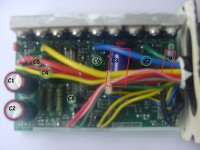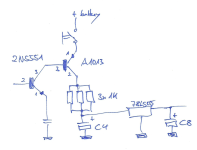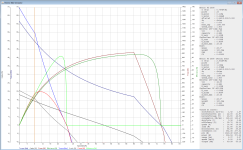Ferreira
10 mW
Hello all!
I modified my motor to be able to climb a hill of ca. 25% grade of ca.200m length, which I encounter at the end of virtually each and every of my rides, and which destroys most of the joy I have with my bike.
Motor and controller of my bike (Daytona, scooterbrasil.com.br) are from Nine Continent. The motor is a JZ48V800W12051000003 (48V, 800W, 120°, 51 poles, I guess). The three coils form a star and each coil is wound with nine parallel wires (AWG22).
Having seen various modifications on youtube and in forums like this one, I opened the motor and divided the three coils into nine coils with three parallel wires. The eighteen ends of the nine coils are lead through the axis (AWG17) where six double selector switches allow me to connect either a star with three parallel coils per branch (original) or a star with three coils in series per branch (high torque/low speed).
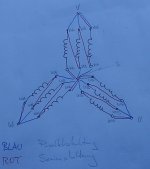
Parallel wiring / wiring in series
View attachment 6
Motor before modification. At 12hrs the three phases, at 2hrs the star point.
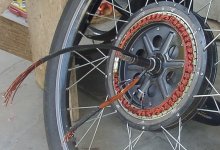
18x AWG17 plus 5x hookup wire for the hall sensors.

Motor after modification.
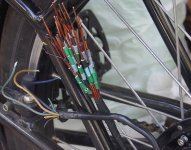
Wires lead outside marked with color codes.

The switches (normally used for 110V/220V switching) 10A/120V 5A/250V. Hopefully 15A/48V. Max. 20mΩ. Measured 7...8mΩ.

Wiring done.
Thank God, everything worked out fine.
Using the parallel mode the bike apparently behaves like before, although there now are additional copper losses as well as losses in the switches which each are around 2% of the battery power (4x 12V 10Ah lead-gel) in the case of high load, and below 1% in typical operation. Using the series mode, the idle speed, which is reached when the back-EMF reaches the controller voltage, apparently is three times lower.
I used the ebikes.ca simulator to determine that the bike climbs 9% grade at 24km/h. Using the series mode, it now should climb 27% at 8km/h. But it does not. The reason is, that in series mode the nominal voltage of the controller should be tripled (144V) while the controller pumps only a third of Amps through the motor and the losses stay the same. I tripled the motor constant, so with three times higher torque at three times lower speed I will need three times higher voltage at three times lower current.
Modelling the Motor as U = R + jωL + Uemf, in series mode R is nine times higher, L is nine times higher, and Uemf is three times higher. Therefore 48V is not enough when climbing a 27% grade at 8km/h.
The simulator says that climbing a 9% grade at 24km/h in parallel mode happens at 45A (controller limits battery current to 22A). Therefore a 27% grade at 8km/h in series mode needs 15A. My calculations (using R = 0.1Ω, L = 0.2mH in parallel mode, R = 0.9Ω, L = 1.8mH in series mode) say that a minimum of 62,2V is required for the controller to be able to feed 15A at this operating point. Thus, having 60V, using a fifth battery (which I have), I should be able to climb the 27% grade at less than 8km/h but more than 5km/h, which would solve my problem.
But how will the controller behave with 60V instead of 48V batteries? Here's a picture of my controller:
View attachment 1
A Nine Continent "Intelligent Infineon E-Bike-Controller". Voltage is 48V. Max. battery current is 22A.
Which modifications are necessary to use the Controller with 60V batteries?
Current should be no problem, in series mode it is three times lower in all cases, including the worst case.
I will have to check the MOSFETs' voltage ratings.
What else do I have to consider, when using 60V? Thanks in advance for helpful comments!
I modified my motor to be able to climb a hill of ca. 25% grade of ca.200m length, which I encounter at the end of virtually each and every of my rides, and which destroys most of the joy I have with my bike.
Motor and controller of my bike (Daytona, scooterbrasil.com.br) are from Nine Continent. The motor is a JZ48V800W12051000003 (48V, 800W, 120°, 51 poles, I guess). The three coils form a star and each coil is wound with nine parallel wires (AWG22).
Having seen various modifications on youtube and in forums like this one, I opened the motor and divided the three coils into nine coils with three parallel wires. The eighteen ends of the nine coils are lead through the axis (AWG17) where six double selector switches allow me to connect either a star with three parallel coils per branch (original) or a star with three coils in series per branch (high torque/low speed).

Parallel wiring / wiring in series
View attachment 6
Motor before modification. At 12hrs the three phases, at 2hrs the star point.

18x AWG17 plus 5x hookup wire for the hall sensors.

Motor after modification.

Wires lead outside marked with color codes.

The switches (normally used for 110V/220V switching) 10A/120V 5A/250V. Hopefully 15A/48V. Max. 20mΩ. Measured 7...8mΩ.

Wiring done.
Thank God, everything worked out fine.
Using the parallel mode the bike apparently behaves like before, although there now are additional copper losses as well as losses in the switches which each are around 2% of the battery power (4x 12V 10Ah lead-gel) in the case of high load, and below 1% in typical operation. Using the series mode, the idle speed, which is reached when the back-EMF reaches the controller voltage, apparently is three times lower.
I used the ebikes.ca simulator to determine that the bike climbs 9% grade at 24km/h. Using the series mode, it now should climb 27% at 8km/h. But it does not. The reason is, that in series mode the nominal voltage of the controller should be tripled (144V) while the controller pumps only a third of Amps through the motor and the losses stay the same. I tripled the motor constant, so with three times higher torque at three times lower speed I will need three times higher voltage at three times lower current.
Modelling the Motor as U = R + jωL + Uemf, in series mode R is nine times higher, L is nine times higher, and Uemf is three times higher. Therefore 48V is not enough when climbing a 27% grade at 8km/h.
The simulator says that climbing a 9% grade at 24km/h in parallel mode happens at 45A (controller limits battery current to 22A). Therefore a 27% grade at 8km/h in series mode needs 15A. My calculations (using R = 0.1Ω, L = 0.2mH in parallel mode, R = 0.9Ω, L = 1.8mH in series mode) say that a minimum of 62,2V is required for the controller to be able to feed 15A at this operating point. Thus, having 60V, using a fifth battery (which I have), I should be able to climb the 27% grade at less than 8km/h but more than 5km/h, which would solve my problem.
But how will the controller behave with 60V instead of 48V batteries? Here's a picture of my controller:
View attachment 1
A Nine Continent "Intelligent Infineon E-Bike-Controller". Voltage is 48V. Max. battery current is 22A.
Which modifications are necessary to use the Controller with 60V batteries?
Current should be no problem, in series mode it is three times lower in all cases, including the worst case.
I will have to check the MOSFETs' voltage ratings.
What else do I have to consider, when using 60V? Thanks in advance for helpful comments!


